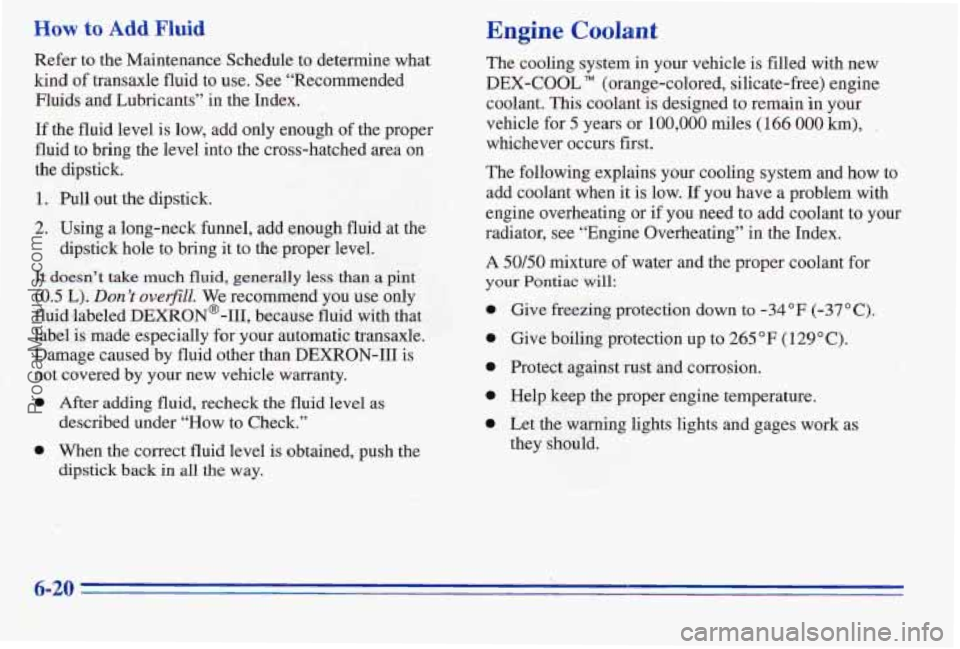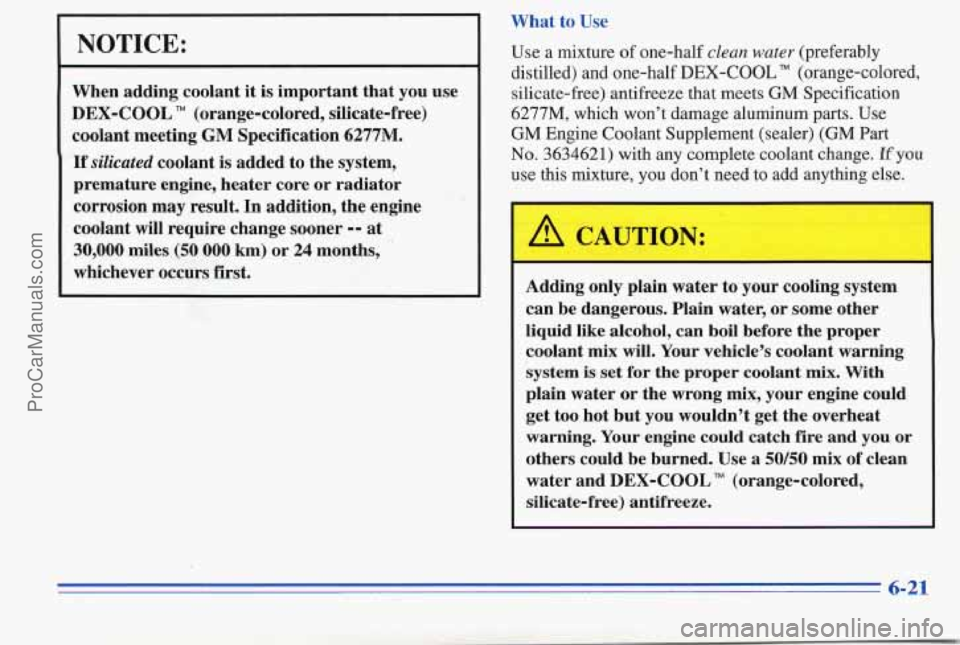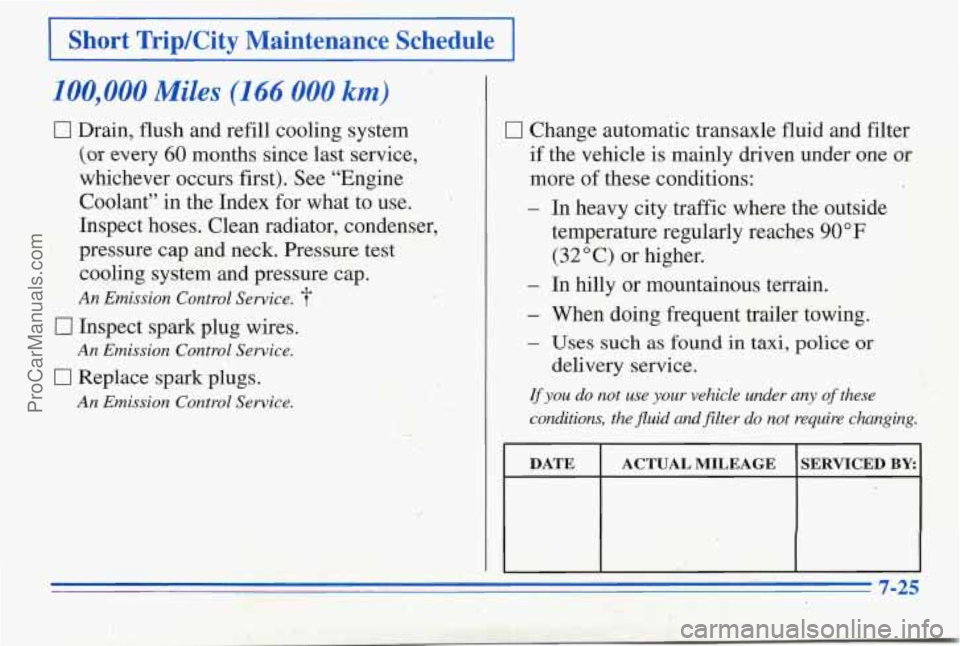Page 235 of 370
When you lift the hood of the 3.1L L82 engine, you’ll see:
A. Engine Coolant Reservoir
B. Radiator Fill Cap
C. Power Steering Fluid Reservoir
D. Engine Oil Fill Cap
E. Engine Oil Dipstick
E Automatic Transaxle Dipstick
G. Brake Fluid Reservoir
H. Air Cleaner
I. Windshield Washer
Fluid Reservoir
J. Battery (located under
Windshield Washer
Fluid Reservoir)
6-8
ProCarManuals.com
Page 236 of 370
When you lift the hood of the 3.4L LQl engine, you’ll see:
1
A. Engine Coolant Reservoir
B. Radiator Fill Cap
C. Power Steering Fluid Reservoir
D. Engine Oil Fill Cap E.
Engine Oil Dipstick
F. Automatic Transaxle Dipstick
G. Brake Fluid Reservoir
H. Air Cleaner
I. Windshield Washer
Fluid Reservoir
J. Battery (located under
Windshield
Washer
Fluid Reservoir)
6-9
ProCarManuals.com
Page 247 of 370

How to Add Fluid
Refer to the Maintenance Schedule to determine what
kind of transaxle fluid to use. See “Recommended
Fluids
and Lubricants” in the Index.
If the fluid level is low, add only enough of the proper
fluid to bring the level into the cross-hatched area on
the dipstick.
1. Pull out the dipstick.
2. Using a long-neck funnel, add enough fluid at the
It doesn’t take much fluid, generally less than a pint
(0.5 L). Don’t oveflll. We recommend you use only
fluid /labeled DEXRON@-HI, because fluid with that
label
is made especially for your automatic transaxle.
Damage caused by fluid other than
DEXRON-111 is
not covered by your new vehicle warranty.
0 After adding fluid, recheck the fluid level as
0 When the correct fluid level is obtained, push the
dipstick hole to bring
it to the
proper level.
described under “How to Check.”
dipstick
back in all the way.
Engine Coolant
The cooling system in your vehicle is filled with new
DEX-COOL (orange-colored, silicate-free) engine
coolant. This coolant is designed
to remain in your
vehicle for 5 years or 100,000 miles (166 000 km), ,
whichever occurs first.
The following explains your cooling system and how to
add coolant when it is low.
If you have a problem with
engine overheating or
if you need to add coolant to your
radiator, see “Engine Overheating” in the Index.
A 50/50 mixture of water and the proper coolant for
your Pontiac will:
0
0
0
0
0
Give freezing protection down to -34°F (-37°C).
Give boiling protection up to 265 “F (129°C).
Protect against rust
and corrosion.
Help keep the proper engine temperature.
Let the warning lights lights and gages work as
they should.
ProCarManuals.com
Page 248 of 370

NOTICE:
When adding coolant it is important that you use
DEX-COOL
TM (orange-colored, silicate-free)
coolant meeting
GM Specification 6277M.
If silicated coolant is added to the system,
premature engine, heater core or radiator
corrosion may result. In addition, the engine
coolant will require change sooner
-- at
30,000 miles (50 000 km) or 24 months,
whichever occurs
first.
What to Use
Use a mixture of one-half clean water (preferably
distilled) and one-half DEX-COOL
TM (orange-colored,
silicate-free) antifreeze that meets GM Specification
6277M, which won’t damage aluminum
parts. Use
GM Engine Coolant Supplement (sealer) (GM Part
No. 3634621) with any complete coolant change. If you
use this mixture, you don’t need. to add anything else.
Adding only plain water to your cooling system
can be dangerous. Plain water, or some other
liquid like alcohol, can boil before the proper
coolant mix will. Your vehicle’s coolant warning
system
is set for the proper coolant mix. With
plain water or the wrong mix, your engine could
get too hot but you wouldn’t get the overheat
warning. Your engine could catch fire and you or
others could be burned.
Use a 50/50 mix of clean
water and DEX-COOL
TM (orange-colored,
silicate-free) antifreeze.
- - 6-21
ProCarManuals.com
Page 249 of 370
NOTICE:
If yos we an improper coolant mix, your engine
could overheat and be badly damaged. The
repair cost wouldn’t be covered by your
warranty. Too much water in the
mix can freeze
and crack the engine, radiator, heater core and
other parts.
If you have to add coolant more than four times a year,
have your dealer check
your cooling system.
I NOTICE:
If you use the proper coolant, you don’t have to
add extra inhibitors or additives which claim to
improve the system. These can’ be harmful.
Checking Coolant
When your engine is cold, the coolant level should be at
the
COLD mqk or a little higher. When your engine is
warm, the level should be up to the HOT mark or a
little higher.
ProCarManuals.com
Page 250 of 370
If this light comes on,
it means you’re low on
engine coolant.
LOW
COOLANT
L
Adding Coolant
A CAUTION:
lhrning the radiator pressure cap when the
engine and radiator are hot can allow steam and
scalding liquids to blow out and burn you badly.
With the coolant recovery tank, you will almost
never have.to add coolant
at the radiator.
Never turn the radiator pressure cap
-- even a
little -- when the engine and radiator are hot.
If you need more coolant, add the proper mix at the Add
coolant mix at the recovery tank, but be careful not
coolant recovery tank. to
spill it.
If the coolant recovery tank is completely empty, add
coolant to the radiator. (See “Engine Overheating”
in the Index.) ’ A CAUTION:
You can be burned if you spill coolant on hot
engine parts. Coolant contains ethylene glycol,
and it
will burn if the engine parts are hot
, enough. Don’t spill coolant on a hot engine.
ProCarManuals.com
Page 251 of 370
Radiator Pressure Cap Power Steering Fluid
NOTICE:
Your radiator cap is a 15 psi (105 kPa)
pressure-type cap and must
be tightly installed to
prevent coolant loss and possible engine damage
from overheating.
Be sure the arrows on the cap
line up with the overflow.tube on the radiator
filler neck.
When you replace your radiator pressure cap, an AC@
cap is recommended.
Thermostat
Engine coolant temperature is controlled by a thermostat
in the engine coolant system. The thermostat stops the
flow
of coolant through the radiator until the coolant
reaches a preset temperature.
When you replace your thermostat,
an AC'thermostat
is recommended.
3.1L L82 Engine 3.4L LQ1 Engine
When to Check Power Steering Fluid
It is not necessary to regularly check power steering
fluid unless
you suspect there is a leak in the system or
you hear an unusual noise.
A fluid loss in this system
could indicate
a problem. Have the system inspected
and repaired.
6-24 -
ProCarManuals.com
Page 328 of 370

I Short Trip/City Maintenance Schedule I
100,000 Miles (1 66 000 km)
0 Drain, flush and refill cooling system
(QT every 60 months since last service,
whichever occurs first): See “Engine
Coolant”
in the Index for what to use.
Inspect hoses. Clean radiator, condenser,
pressure cap and neck. Pressure test
cooling system and pressure cap.
An Emission Control Service; ~~~~.~ ,~
An Emission Control Service.
I
,. .“,-*$ .J$?
0 Inspect spark plug -wires.
0 Replace spark plugs.
, I .. .. -. .,, .
An Emission Control Service.
c
0 Change automatic transaxle fluid and filter
if the vehicle is mainly driven under one or
more of these conditions:
- In heavy city traffic where the outside
temperature regularly reaches
90 OF
(32 O C) gr higher.
- In hilly or mountainous terrain.
- When doing frequent trailer towing.
- = Uses such as found in taxi, police or
If you do not use your vehicle under any of these
conditions, the jluid
and filter do not require changing,
’ . , ..VI -
.‘ . .: delivery service.
ProCarManuals.com